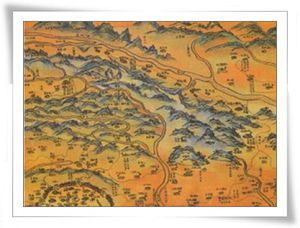| |
Brief Introduction of Lujhu |
|
 Da-she Section in the township is the historical site of the ancient Taburian. Native-Taiwanese people had been residing nearby Da-she. In Yung-Li 14 (A.D. 1660), Koxinga landed on Taiwan with his troops and expelled the Dutch. He then established the county system and set up one government office and two counties. Da-she Section in the township is the historical site of the ancient Taburian. Native-Taiwanese people had been residing nearby Da-she. In Yung-Li 14 (A.D. 1660), Koxinga landed on Taiwan with his troops and expelled the Dutch. He then established the county system and set up one government office and two counties.
At that time, the township belonged to Wan-nian County. In Yung-Li 18 (A.D. 1664), Wan-nian County was changed to Wan-nian State. And the regions were divided up again to Wen-sian and 24 other districts. Among the 24 districts, Chang-jhih District and Wei-sin District were both governed by today's Lujhu Township.
In Kang-Si 22 of the Qing Dynasty (A.D. 1683), the Qing military landed on Taiwan. The very next year, the Qing government renamed Cheng-tian Government Office to Taiwan Government Office of Fujian Province, which was further separated to Taiwan County, Jhuluo County, and Fongshan County. Today's Lujhu Township was under the governance of Fongshan County. In Kang-Si 32 (A.D. 1693), Gao Gong-Chien revised the Gazetteer of Taiwan Prefecture and named the three major streets in Fongshan County to Anping Village Street, Ban-Lujhu Street, and Singlong Street. It was the first time the name Ban-Lujhu Street appeared in a historical document, and it also showed the prosperity of Ban-Lujhu Street at that time. In Cian-Long 29 (A.D. 1764), Wang Ying-Zeng revised the Gazetteer of Fongshan County and recorded, “Ban-Lujhu Street is in Wei-sin District, which is 40 kilomiter north of the County Capital, under the governance of the Government Office”. Regarding the origin of “Ban-Lujhu”, one explanation that is more widely accepted is that the place is 20 kilometers away from Shih-ping in the north and 26 kilometers away from Fongshan in the south. Thus, the place is about half way in between the Shih-ping and Fongshan (the Chinese word for half is ban). At the same time, there are forests of bamboo woods here that served as a resting place for business travelers, therefore the place received the name “Ban-Lujhu”. Another legend has it that the word “half” in Mandarin has the same sound (ban) as “tripped”in Taiwanese, meaning there are forests of bamboo woods in the area that were interrupting the traffic and causing inconvenience for pedestrians. As a result the place was called Ban-Lujhu
Min-Guo 9, Taiwanese local system was reformed and the new system was implemented on October 1st. Taiwan was set up with five States of Taipei, Sinjhu, Taichung, Tainan, and Kaohsiung. Under the State, counties and cities were set up and district system was changed to village system. Gangshan County Office in Kaohsiung State under the system was set up in Gangshan Village. There were a total of five villages under the governance of Kaohsiung State besides Gangshan, and they are Lujhu, A-Lian, Hu-nei, and Mi-tuo (which was also when Ban-Lujhu was first eliminated with the word Ban and renamed to be Lujhu). Lujhu Village was set up with a Town Hall and a village chief, with a temporary office in Tian-hou Temple. The governing area includes everything within the original Yi-jia Region. The borders set under the system remained unchanged until the recovery of Taiwan. The village office was built in November, Min-Guo 12, and was renovated in Min-Guo 66 due to the condition of worn-out office halls. Therefore, in Min-Guo 84, a new piece of land was found for building an administrative office building. Finally in July, Min-Guo 86, the village office was moved to its new location in Guo-chang Road.
In Min-Guo 34, after the victory against the Japanese military and with the recovery of Taiwan, Lujhu Township Office was established with Lin Nao-Chang as the Lujhu Village Chief during the transition period. Japanese street and village system was still in place during the transition period. Township Offices were established according to the existing villages from the Taiwan Province Township Organization Procedure. The Japanese Baojia system was abolished and was replaced with village/district/neighborhood system. The Township Office divided up the original governing region of Lujhu from the Japanese Colonial Period into sixteen villages. And they were Jhu-wei, Sia-keng, Jia-nan, Jia-bei, She-dong, She-jhong, She-si, Jhu-dong, Jhu-si, Wen-nan, Wen-bei, Sia-liao, Hou-siang, Bei-ling,San-yeh, and Ya-liao, with a total of 214 neighborhoods under the governance of the villages. Per the rule of the administrative region adjustment project in Min-Guo 39, Jhu-hu Village and Ding-liao Village originally governed by Hu-ne Township were re-assigned to be under the governance of Lujhu Township. On the other hand, Sin-da Village (the original Sia-liao Village) was renamed on October 1st , Min-Guo 64. Jhu-nan Village was separated from Jhu-dong Village on October 1st, Min-Guo 74. She-nan Village was separated from She-si Village on October 1st , Min-Guo 78. With the additional villages and population migration, the number of neighborhoods has changed over the years with a total of 20 villages and 394 neighborhoods in today's administrative governing region. |
|
|